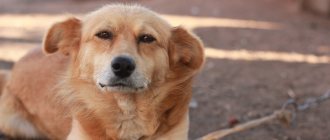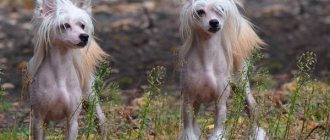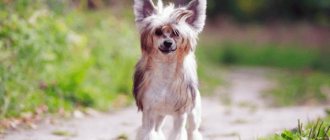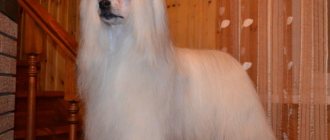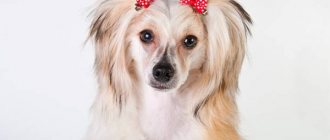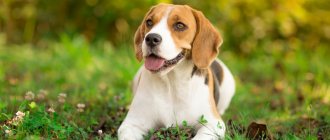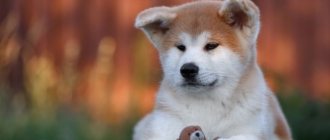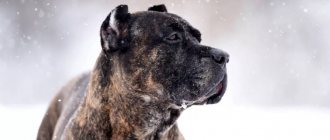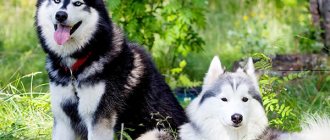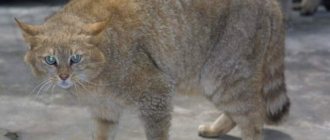Breed characteristics
| Short description | |
| Origin: | China |
| Conditions of detention: | Apartment, including a small one |
| Purpose: | Decorative, indoor |
| Color: | Any, in different combinations, the presence of vague dark spots of a round shape |
| Wool length: | For the hairless variety: absent on the body, small tufts of hair on the head (crest) and tail For the powderpuff variety: soft, long, with undercoat |
| Adult dog size: | Females: from 23 to 30 cm; Males: from 28 to 33 cm; Weight does not exceed 4-5 kg |
| Average life expectancy: | 13 – 15 years |
| Walk: | Not required |
| Physical activity needs: | Low |
| Fédération Cynologique Internationale (FIC) classification: | Recognized in 1987. Group 9; Section 4. Hairless dogs |
| Puppy price: | From 10 to 50 thousand rubles. |
Pekingese
- Height: from 15.3 to 23 cm
- Weight: up to 6.5 kg
- Life expectancy: 12 to 14 years
- Average cost: from 750 to 1500 dollars
Legend has it that Buddha created the Pekingese by shrinking a lion. Well known for its regal mane and fluffy fur, the Pekingese was considered sacred by the imperial family of the Tang Dynasty in the 8th century.
Fun fact: Pekingese are named after Beijing. Initially, only members of the royal family could own them, and theft was punishable by death.
An inflated ego is still present in the breed today, and the Pekingese is sure to become the king or queen of your home. Since the Pekingese is a brachycephalic breed , it is important to keep it away from the heat. Veterinarians recommend taking an ice pack or a portable fan with you on walks in the summer to cool your four-legged friend.
History of the origin of the species
The origin of the Chinese Crested Dog is shrouded in numerous secrets and legends . Judging by the name, China can be called the birthplace of this breed. However, there is another version, according to which the breed has an “African origin,” and it was from the African continent that the Chinese Crested began to spread to other continents.
It is likely that Egyptian sailors on their sailing ships initially brought this breed to the southern part of the Eurasian continent, from where it spread to South America and China. This interpretation is supported by the fact that Egyptian navigation has a rich history dating back thousands of years, and artifacts confirm that the “hairless” dog was known to the Egyptians. At the same time, the geographical isolation of China up to the 2nd century BC is taken into account.
It is this period that can be considered the time when the Chinese Crested appears on the territory of the country and its active breeding begins.
How the Chinese Crested from China gets to central Europe is not known for certain . Since the 16th century, images of the Chinese Crested Dog have increasingly appeared in works of art, in particular in paintings by Flemish and Swiss artists. Later, in the 17th century, information about this breed appeared in printed books and magazines.
Thus, the Chinese Crested was known not only in Europe for a long time, but it received true recognition only in one country - England, where it came through the efforts of the collector Taunton at the end of the 19th century. Initially, the breed does not attract much attention from dog lovers, but gradually becomes very widespread and conquers both the European and American continents.
However, despite such an “ancient” origin, the breed received official recognition only in 1987. Since then, the number of Chinese Crested kennels has been rapidly increasing around the world, and fans of this small dog are charged with the positive emotions that come from it.
Crossbreed
The Chinese Crested Dog has an exotic appearance, which provokes the appearance of mixed breeds. Accidental matings are also common.
Common crossbreeds include:
- Pug and Chinese Crested mix. This cross is called Khokhlomops. She looks like a hairless pug with high-set ears and tufts of hair on her face. The skin appears rough, reminiscent of a hippopotamus.
- Mixed Chihuahua and Chinese Crested. This mix looks like a hairless Chihuahua, with a deformed muzzle and a crest on the top of its head. It was these mestizos that more than once received the title of the ugliest dog in the world.
- Spitz and Chinese Crested mix. The rarest cross. Spitz and Hairless Crested mixes are practically never found, and their cross with Powder Puffs looks quite cute.
Unfortunately, most mestizos suffer from genetic abnormalities and have a short life expectancy.
Distinctive features
The Small Chinese Crested Dog can be easily identified by the following characteristic features::
- The head is small, elegantly shaped, smooth, with no furrow.
- The skull is rounded and elongated.
- The ears are strong, erect (for the Powderpuff species they are drooping), low set, and not cropped.
- The stop is not expressed.
- The muzzle is short, slightly narrowed, flat.
- The cheeks are narrow.
- Eyes with a wide set, medium; very dark, almost black, shiny. The whites are not visible.
- The nose is narrow and can be of any color.
- The lips are tight.
- The teeth are strong, strong, and can be of different lengths.
- The jaws are strong.
- bite .
- The neck is slightly arched, dry, smooth, elegant.
- The body is proportional and elegant.
- Skin without wrinkles, bare (for the bald type), even, clean, smooth, spotty.
- The back is straight.
- The hips are rounded, with pronounced muscles.
- The chest is rounded.
- Shoulders are narrow.
- The limbs are elongated, straight, perpendicular to the body.
- The paws are narrow, long, “hare-like”, and the stance is straight.
- The claws are long.
- Movements are smooth and energetic.
- The tail is thin, long, and in its natural state hangs down; during movement, slightly curved towards the body.
- color , in different combinations, the presence of vague dark spots of a round shape.
Chinese Crested dogs come in two varieties. Depending on the presence and thickness of the coat, they are divided into hairless and powderpuffs:
- Bald Chinese Cresteds have no fur on their bodies and their skin appears bare. But if you look closely, the dog’s body is covered with thin, soft fluff, which can have varying degrees of density - from extremely low to clearly visible. None of these options are a departure from the standard. The fur is usually located on the hind legs and slightly on the shoulder blades. However, hair may also be present in small tufts along the spine and on the hips. In any case, the coat consists of sparse, usually coarse hairs that must be removed regularly every 1.5-2 months. The chest, sides of the body and belly are smooth, hair is completely absent.
- Powderpuffs have soft, long hair all over their body and also have an undercoat.
No matter what variety the Chinese Crested belongs to, what distinguishes this breed is the presence of hair on other parts of the body . These are characteristic small tufts of hair on the head (bangs, tuft, any length, lush, thick or sparse are allowed, falling in a curl) and tail (characteristic plume).
The Chinese Crested can be conditionally divided according to another characteristic - constitution. Depending on the structure of the croup, they are called “deer type” and “pony” (another common name is “conics”):
- Deer type . Dogs of this variety have a thinner bone structure and look more elegant than their relatives.
- Ponies are strong, stocky representatives of the breed. They are distinguished by an emotionally calm, confident, balanced character. There are short hairs on the body, while the neck, head and paws are covered with thick hair.
Regardless of the classification of the adult, Chinese Crested puppies can be born either completely naked or with fur on the rump. In this case, “naked” and “powderpuffs” can appear in the same litter.
Interesting Facts
Over the centuries-old history of the existence of the Chinese Crested, a lot of interesting things have happened to the breed:
- These dogs were highly valued in China. Local residents considered them sacred and attributed magical properties to them. And modern Chinese consider KHS to be the personification of love and prosperity.
- There is a beautiful legend associated with Chinese crested cats. According to her, the dog found a lost baby in the forest. To protect the baby from the cold, she gave him all her fur. As a token of gratitude, the baby’s parents took the dog home, and the forest spirits left the four-legged savior a new appearance.
- Each Chinese Crested has a recessive gene that is responsible for the presence of long hair. Therefore, one litter can have both hairless and fluffy puppies.
Expert opinion
Leonid Rodin
Experienced dog breeder
Ask a Question
The unusual crested dog is an example that breaks stereotypes. Everyone is accustomed to the fact that exotic breeds were bred somewhere in the Chinese provinces for centuries, and then found their way to Europe and America. Here everything happened the other way around - the ancestors of this dog lived either in Mexico or in Africa. Then they migrated to China, where they were subjected to selection, and later returned to their “historical homeland.” The unusualness of hairless crested dogs is expressed in everything. Firstly, they have sweat glands, with the help of which their body temperature is regulated. Secondly, the shape of the elongated legs is very reminiscent of rabbit feet, rather than ordinary dog feet. It’s unpleasant, but true – since 2002, Chinese Cresteds have won ugliest dog shows 9 times. True, there we are most often talking about animals that have been injured due to human cruelty.
Photo of an adult dog
Photos of puppies
Features of character and behavior
The Chinese Crested is an example of devotion to its “pack”, in which it includes all family members. Friendly to people and other pets, this dog will get along with both owners and guests and will bring exceptional joy from communication. No breed can compare with it in its desire to constantly be near a person.
Physical and emotional contact is very important for the Chinese Crested, and owners should always remember this.
The Chinese Crested can be timid and hesitant in unfamiliar situations. Therefore, if frequent joint “outings” are planned, it is recommended to accustom the Chinese Crested to a change of environment from puppyhood. Otherwise, unnecessary problems may arise with adaptation to places unknown to her, and, instead of the joy of interaction, it will turn out to be “a complete hassle.”
A dog of this breed requires constant care and attention, in the absence of which it can become nervous, expressing its dissatisfaction by constant barking. She needs to be provided with regular caresses, touches, active games and contact with people. Then her cheerful, cheerful and affectionate character will be fully revealed, and she will bring daily pleasure from communication.
Advantages
- The undoubted advantage of the Chinese Crested is its docile nature. She is an ideal friend and companion who does not require special invitations to play. The Chinese Crested cat responds gratefully to any interaction and can instantly improve the mood of its owner.
- Very well suited for people who have no experience in keeping dogs , as it practically does not require special knowledge in the field of dog breeding.
- It is believed that the Chinese Crested is suitable for allergy sufferers, as it has little or no hair. However, you need to keep in mind that allergies are usually caused not by fur, but by proteins that are secreted by the skin, saliva, and urine of the animal. The common belief about “hypoallergenic” dogs is wrong. If future owners suspect allergies, it is necessary to first pass tests for allergens of this particular breed in order to avoid the need to part with the animal after it gets into the house.
- The Chinese Crested does not show aggression and is always friendly.
- Another advantage is that there is no need for walking.
Flaws
The disadvantages of the Chinese Crested are few and boil down to the following:
- The breed is not suitable for people who are often away from home for long periods of time. Those owners who do not have the opportunity to spend a lot of time with the dog should not choose the Chinese Crested. They cannot stand loneliness. Soft toys can only partially satisfy the high degree of necessary human communication. Any prolonged absence of the owner or other family members is perceived by them as a “tragedy”, which adversely affects the nervous activity of dogs. They become nervous and irritable. Adaptation of an adult dog to another family is impossible without damage to the animal’s psyche.
- The second problem that owners may encounter is tooth damage due to frequent chewing of various objects. It must be borne in mind that this behavior of the pet is a consequence of its isolation, so you should not leave the dog unattended for a long period.
- It is not advisable to keep a dog in a family where there are small children aged 1 to 4 years. Given the relative fragility of the bone structure, it can be reluctantly damaged in the game.
Price of Chinese Crested
The Chinese Crested is considered an elite and relatively expensive breed. The average price of such a dog is 12-75 thousand rubles.
The cost of a puppy depends on the breed type, the reputation of the kennel, the titles of the parents and the absence of defects in the exterior. A hairless Chinese Crested is worth more than its furry littermate. And a puppy without documents is sold cheaper than those with a good pedigree.
Chinese Cresteds are miniature dogs with an extraordinary appearance and affectionate character. Perky and cheerful animals will become a living decoration of any home and will repay your caring attitude with selfless devotion.
Care and maintenance
No special conditions are required for keeping the Chinese Crested . Having a soft bed is welcome, but not required. The dog will happily spend most of its time next to its owner - in the arms or on the sofa.
- The Chinese Crested requires not only constant attention and communication. Caring for this breed, although not particularly difficult, does involve a large number of regular procedures.
- You need to bathe your dog once a week . It is best to use gels that soften the skin and shampoos that increase volume and add shine (for the tuft and plume on the tail). For washing, soft sponges made from natural materials are usually used. After bathing, you can dry the dog with light touches with a terry towel and be sure to lubricate the skin with a moisturizing cream of liquid consistency.
The skin of the Chinese Crested, regardless of the variety, requires care with special creams, especially in the summer.
- Ears must be cleaned of dirt and wax every 3-4 days . Before carrying out this procedure, it is recommended to restrain the dog in any convenient way (the “swaddling method” is often used, as with infants). The use of special products is recommended, but the use of ordinary water is also acceptable. Cleaning is carried out extremely carefully, since the ear cartilage of the Chinese Crested is a weak point.
- Eyes need regular monitoring . It is best to examine them daily immediately after sleep, in the morning. The eyes should be black and shiny. If a change in color or loss of shine is detected, the dog should be taken to a veterinarian.
- Teeth must be brushed to remove plaque and tartar once every 2 weeks . The procedure begins when the puppy's molars appear - from about 6-8 months of age. However, like other dog breeds, Chinese Cresteds do not like these manipulations. To accustom her to brushing her teeth in the future, you can apply a “play” technique to the puppy - with a finger wrapped in clean gauze, imitate “biting” while massaging the gums. The use of special toothpastes enriched with vitamins is mandatory.
- The Chinese Crested's claws also require close attention . Due to the special structure of the paw, the so-called “hare’s paw,” the claws grow quickly and practically do not wear down during walks. Therefore, they need to be trimmed as they grow. Given the diminutive nature of dogs, it is recommended that the procedure be carried out in a veterinary clinic so as not to damage the living part of the claw.
Nutrition
The feeding of the Chinese Crested has its own characteristics.
- These dogs, despite being highly physically active, usually do not have enough exercise and are prone to weight gain.
- It is preferable to feed dogs dry food, giving preference to the Premium and Premium Plus classes (Hills, Natural Holistic, Purina Pro Plan for miniature and dwarf breeds), which contain vitamins and minerals.
- The ideal option would be dietary food for both a puppy and an adult dog.
- As a treat, Chinese dogs can be given boiled vegetables (carrots, cabbage, pumpkin, zucchini) and fruits (chopped apples), no more than once a week.
We also accept a natural diet.
In this case kefir , cottage cheese (no more than 1%), weak meat broths , lean meat (veal, soft part of beef), fish (low-fat varieties of sea fish), fresh yolk (once a week), vegetables and fruits are used. .
It is not recommended to include raw meat in the menu.
Lamb, pork, bones, poultry, river fish, potatoes, all types of legumes, onions, and any confectionery and flour products are completely excluded from the diet.
- Feeding a puppy under the age of 8-9 months consists of 4-5 daily feedings in small portions, the daily volume is 50-60 grams. (half a handful). The main rule in feeding a puppy is adherence to the regime.
- It is necessary to feed your pet at the same time throughout the day.
- An adult dog (starting from 9-10 months) eats 2 times a day , the volume of each serving should not exceed 50-60 grams.
It is recommended to arrange fasting days once a week and feed the Chinese Crested with boiled vegetables.
Health
The Chinese Crested is sensitive to any changes in living conditions . In addition to the characteristic diseases that require veterinary intervention, these dogs need to create comfortable mental conditions - constant contact with people. The immune system of the breed is not particularly strong. Stress caused by the need to be alone for a long time does not promote health.
Any change in behavior - decreased activity, disinterest in communication and games - requires immediate contact with a veterinarian. Self-treatment with Chinese Crested can be fatal.
Vaccinations
Chinese crested vaccinations are carried out according to the scheme of primary vaccination at 8-9 weeks and revaccination at 12 weeks against diseases to which all dogs are susceptible: distemper, hepatitis, enteritis, parainfluenza and coronavirus.
Throughout their lives, dogs are vaccinated annually , following the general rules for vaccinations: the pet must be healthy and dewormed.
Diseases
The health of the Chinese Crested requires constant monitoring. The following diseases are typical for this breed:
- Keratoconjunctivitis sicca is a lack of sufficient tear fluid. As a result of insufficient moisture, the cornea becomes irritated and the conjunctiva becomes red, which can lead to complete blindness . To prevent this from happening, the eyes of the Chinese Crested must be examined daily, and at the slightest suspicion of illness, consult a doctor.
- Folliculitis – crusts on the skin, peeling. Usually of a bacterial nature, treatment is carried out only with antibiotics .
- Legg-Calvé-Perthes disease is a necrosis of the femoral head characteristic of small breeds of dogs. Unfortunately, diagnosis at an early stage of development (2-3 months) is difficult. The disease usually develops rapidly at the age of 8-12 months, treatment is only surgical .
- Cystitis, pyelonephritis. To avoid such cases, it is recommended to reduce or eliminate the walking of the Chinese Crested in the cold and damp seasons.
- Allergy to gels and shampoos.
Walk
The undoubted advantage of the Chinese Crested is the absence of the need for mandatory daily walking. Keeping a dog in an apartment will be appreciated by owners who are not prone to frequent walks. At the same time, in order to maintain cleanliness in the apartment, the dog must be trained to use a tray (or disposable diapers) immediately after its arrival in the family.
Despite the fact that the Chinese Crested is considered an indoor dog, it should not be completely deprived of active outdoor play. For walks you will need special overalls depending on weather conditions. For the spring period, it is recommended to buy insulated clothing with synthetic padding; in the summer it is preferable to use “breathable” materials. To avoid sunburn, it is best to avoid prolonged exposure to direct sunlight and use sunscreen.
During the damp and cold autumn-winter period, it is better not to expose the dog to hypothermia and not to walk it.
Tendency to diseases
Chinese Cresteds have good health. However, sometimes there is a tendency to the following pathologies:
- allergies;
- dental diseases;
- acne;
- destruction of the hip joint;
- dislocated knees;
- chronic drying of the mucous membrane of the eyes;
- urinary tract diseases;
- sunburn.
Dogs live on average 12-13 years, but there are individuals known that lived up to 16 years. Life expectancy is influenced by the quality of maintenance, walks, and stressful situations.
Grooming
Coat care depends on the variety of Chinese Crested.
- Hairless dogs have no hair . Therefore, body care consists of removing sparse hairs from the rump using tweezers. Hair removal is allowed in a veterinary clinic.
- Powderpuffs require daily brushing of their hair, which if not properly cared for can become matted, causing significant discomfort.
Regardless of the type, you need to keep in mind that the Chinese Crested does not shed, so it is not possible to get rid of unnecessary hair on its own . The hair on the head, paws and tail should be brushed daily. A comb with a large distance between teeth is best for this procedure.
The dog's face also requires additional care . It is recommended to shave all hairs weekly, and treat the skin with special disinfectants and moisturizers.
It is not recommended to use drugs intended for humans, as dogs are prone to allergic reactions.
Mating
Chinese crested mating involves a number of rules that must be followed in order to achieve the desired result. In general, crossbreeding between Chinese Crested varieties is permitted in any combination. However, it must be remembered that the gene that determines the degree of hair fouling is dominant. So, when mating a hairless individual and a powderpuff, most likely the litter will be “mixed-haired”, it will contain both hairless and fur-covered puppies.
The constitutional types “deer” and “pony” usually do not mix when crossing. This is especially important for those cases when you plan to show a dog - as a result of mixing, most likely, you will get an intermediate type that will be disqualified.
Otherwise, the crossbreeding of representatives of this breed is subject to the basic rules for mating dogs of other breeds:
- carried out on the territory of the dog;
- carried out on an empty stomach, preferably in the morning;
- despite early puberty (by the first year of life), it is not recommended to mate dogs under 18-20 months of age;
- mating of close relatives is not allowed.
Diseases
Some crested dogs develop allergies to fur. In addition, representatives of the breed may suffer from various musculoskeletal disorders.
These include hip dysplasia, luxating patella and Perthes disease (destruction of the head of the femur).
Powder Crested puppies often suffer various injuries. They cannot correctly calculate the trajectory of the jump and can break their paws. The owner should spend some time helping his pet jump off a chair or bed. Slippery floors can also pose some danger to your puppy. It is better to cover parquet or linoleum with carpets.
Key points in training
The Chinese Crested is trainable and can successfully learn many commands from the OKD course . However, it must be remembered that its main purpose is not to “fiercely” protect the owner, but to give him aesthetic pleasure. For this reason, it will be much better to try to teach the dog various circus tricks - jumping on its hind legs, jumping on pedestals, taking a vertical stance.
Read about how to properly train a dog in the article: “Training a puppy: effective methods from dog handlers, learning commands at home.”
Tibetan Spaniel
- Height: from 21 to 26 cm
- Weight: from 4.1 to 6.8 kg
- Life expectancy: 12 to 15 years
- Average cost: from 1500 to 3500 dollars
The Tibetan Spaniel is another very old Chinese dog breed, and it's not actually a spaniel either! Bred in the Himalayas almost 2,500 years ago, the Tibetan Spaniel was one of the best watchdogs of Buddhist monasteries. Despite his small stature, the Tibetan spaniel did his job well - the dogs sat high on the walls and barked loudly when strangers approached. Thanks to its innate protective instincts, the Tibetan Spaniel will be an attentive and excellent protector of the home.
How to choose a puppy
Choosing a Chinese Crested puppy is a kind of lottery, since sometimes even an experienced breeder cannot predict the color of a future adult dog.
- The main point in deciding which puppy to take home should be the owner’s understanding of the specifics of caring for the fur of these animals.
- If future owners are not willing to spend too much time combing their hair, it is preferable to adopt a hairless Chinese Crested.
- Assessing his bite can provide some help in choosing the type of puppy. According to the standard, powderpuffs have a regular bite, while hairless individuals have fangs that protrude slightly forward.
In any case, the puppy should be active, sociable, with shiny eyes and smooth skin.
The Chinese Crested is an exceptionally intelligent and quick-witted dog. The almost complete absence of aggressive tendencies makes her desirable in any home. This breed is able to completely adapt to the character of its owners and become an inexhaustible source of cheerfulness and good mood.
5 / 5 ( 1 voice )
Tibetan Terrier
- Height: from 35.5 to 43.2 cm
- Weight: from 8.2 to 13.6 kg
- Life expectancy: 15 to 16 years
- Average cost: from 1000 to 1500 dollars
Referred to as the "sacred dog of Tibet" , this Chinese dog has been associated with ancient Buddhist monasteries and the Dalai Lama, serving a variety of roles as companions, watchdogs and shepherds. They are believed to be native to the Lost Valley of Tibet.
Fun fact: the Tibetan Terrier is not actually a terrier at all. This name was given by European travelers who felt that this breed was very similar to European terriers.
The Chinese believe that the Tibetan Terrier brings good luck . Of course, anyone who owns one of these long-haired beauties feels lucky, as they are a highly adaptable breed well suited to family life. Tibetan Terriers thrive on human contact and make excellent therapy dogs.
With a protective double coat of fur and large, flat, round feet that provide excellent traction—almost like snowshoes—Tibetan Terriers are well suited to life in snowy regions.
